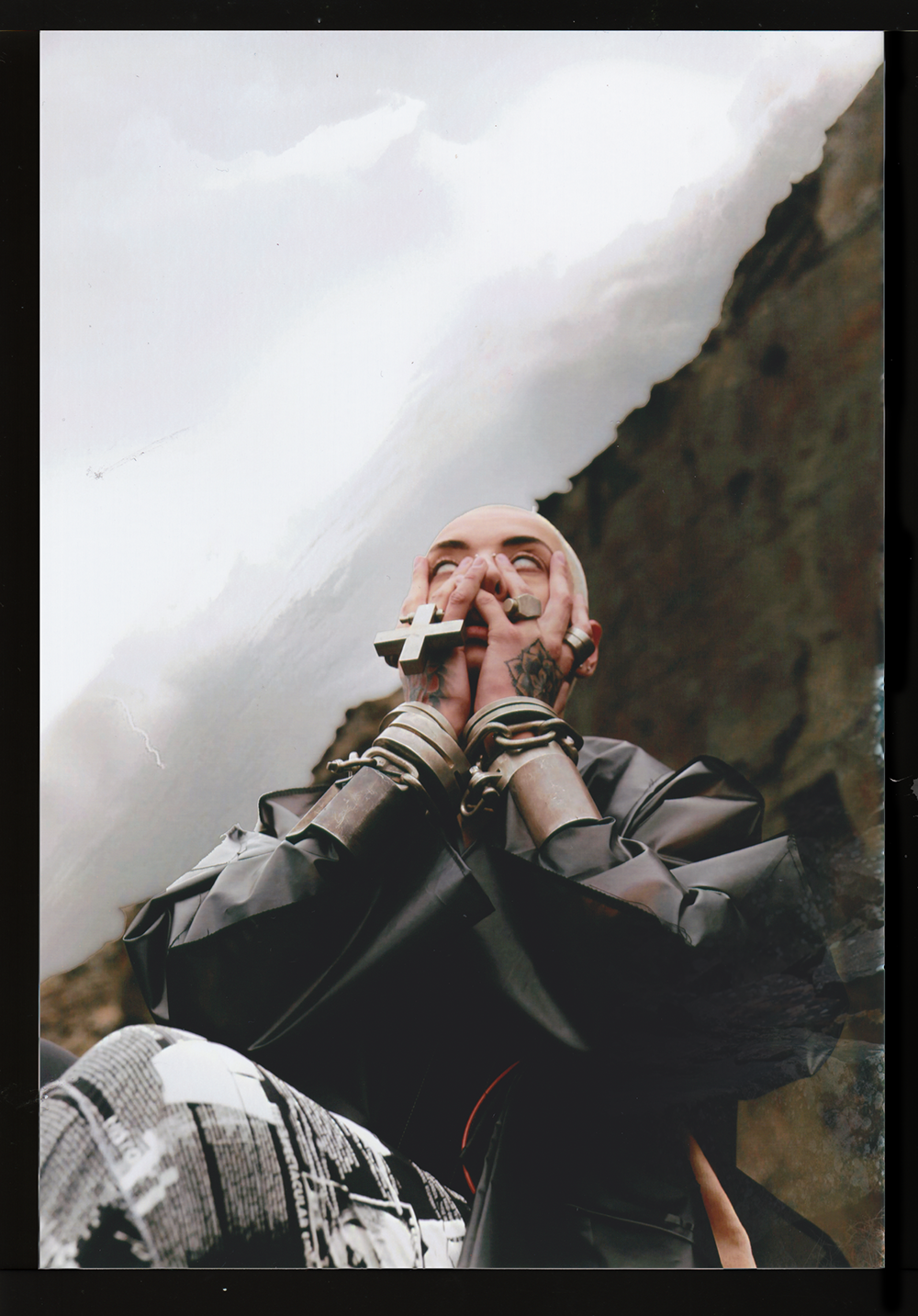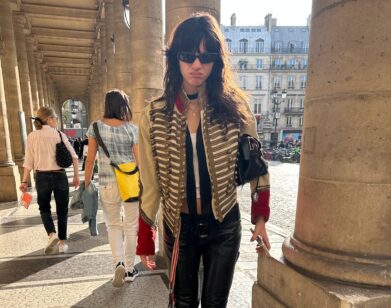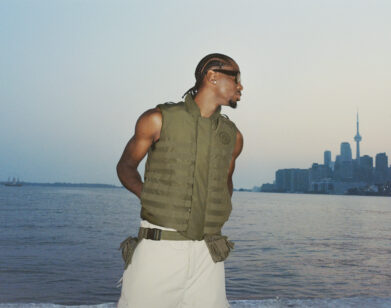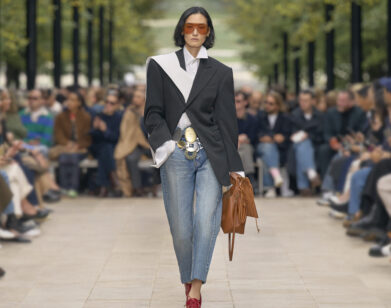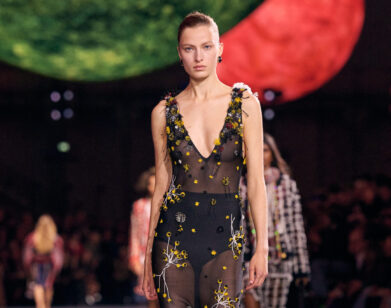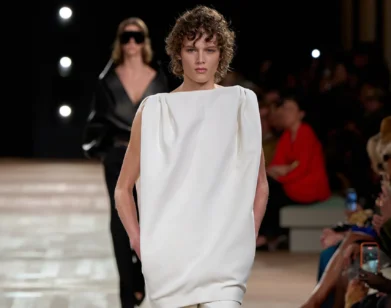GAIKA makes futurist clothing for a secretive motorcycle gang
In September of 2017, the London artist and genre-averse musician known as GAIKA wrote a chilling, Adam Curtis-level essay titled The Spectacular Empire. It described a fictional domino of political events starting in 2018 that would lead to a new civilization ruled by a secretive motorcycle gang. The gang in question clothed themselves in highly engineered protective garments called Armour in Heaven, which emerges in the year 2047. This captivating science fiction narrative has gone on to inform GAIKA’s pair of Warp-released EPs The Spectacular Empire I & II, along with The Spectacular Empire tour that he embarked on late last year. And now, Armour in Heaven has become a real clothing line.
The brand’s genesis occurred back in 2015, when GAIKA’s then-housemate—Central Saint Martins educated designer (MA) Menikmati—saw the potential for a clothing-based interpretation of the musician’s thoughts on the future. The pair began an exchange of ideas that would lead to this politically charged project. Armour In Heaven aims to empower its wearer both ideologically and practically.
“Armour is protection for the user,” explains (MA) Menikmati. Gaika adds that clothing “can be an agent of justice as well as more simply a billboard of intent.” He adds that the brand is informed by the Ninja myth, emphasizing tactile usage in terms of “survival, the need to avoid detection in low light, and protection whilst moving at speed.” While both artists consider Armour In Heaven more of a philosophy than a traditional clothing brand, the garments they produce are nevertheless detailed high fashion pieces, while the concept’s visuals align them with contemporary street-level production and styling.
We talk to both artists about how their ideas came together, and delve deeper into Armour In Heaven’s mythical manifesto.
KAMILA RYMAJDO: How did you meet each other?
MENIKMATI: We knew of each other through similar work circles, design and events, but properly when GAIKA moved into mine [in Manchester]. We were talking the first night about clothing—I always have pieces or samples where I’m staying.
RYMAJDO: GAIKA was working on his debut EP Machine at the time. What appealed to you about his music?
MENIKMATI: It had a similar sound to what I listen to when I’m working but was unlike anything I’d heard. The music is emotive, it built audio landscapes in my head.
RYMAJDO: How did the music influence the clothing you were initially planning to make?
GAIKA: The music comes from an entire world I have built in my mind. Naturally, that place is populated with people who dress to my taste. I guess it’s all coming from a particular aesthetic.
MENIKMATI: The idea was to create stagewear or costume—a constant revolving source of outfits for live shows and touring, so there’s some heavily worn tops and jackets in storage.
RYMAJDO: How did that evolve into Armour In Heaven?
GAIKA: I felt like we were super strong making outerwear and people kept asking me where I got my jackets from so we decided to make a few more.
MENIKMATI: GAIKA’s writing has influenced the Armour In Heaven concept through conversations of how the clothing relates to the forward ideas he creates.
RYMAJDO: There’s a strong sense of narrative within the brand—the detailed item descriptions and texts, some taken from your writing, GAIKA. Do you see clothing as strong a tool of political resistance as music?
GAIKA: How you dress has a direct impact on people’s emotions so, yes, I do see it as just as strong a tool of resistance, just more subtly. How you clothe yourself can subvert power from the powerful and also empower the powerless.
RYMAJDO: What were the aesthetic influences of the first collection?
MENIKMATI: The human form at night. The clothing I’ve always made has been industrial, and the shapes geometric and kind of future. Some of it became hybrids of upcycled squad gear and constructed fabrics, vests with the pockets stripped and layered with contrasting material, apocalypse gear. The conversation was always where the clothing sat in time and space, so those ideas are why the clothing looks like that.
GAIKA: It’s influenced by kid shit, like Ninja movies and Gundam and running about in army surplus gear my mum used to get use because we were broke. There’s a romance to it for me and I can definitely see the background in illustration we share.
RYMAJDO: Can you explain what kind of specific situations the clothing is designed for?
MENIKMATI: There are different items and combinations of items that are specifically designed for different situations, flight, presentation, reproduction, combat… These are all listed in the descriptions of the garments—anything essential to survival. It’s all designed for a different space and time. Latex for example is a high protection fabric, the Kevlar of this world.
RYMAJDO: What’s the significance of the colour palettes?
MENIKMATI: Significant in that the items are the colours they need to be. Black for low light stealth, gold for presentation and power, gunmetal for action, flight and recognition, red for warning and skin tone for peace.
RYMAJDO: In previous promotional material you assert Armour in Heaven is celebratory of migration and the immigrant—how is that expressed within the construction of the garments?
MENIKMATI: A celebration of migration and the immigrant is celebration of the human race itself. The clothing is bold in its shape and raw in construction, the cuts fit and celebrate the human form equally.
GAIKA: Design wise there’s a certain amount of culture smash going on and it’s deliberate. The garments are designed to be worn on the move and to be geographically unplaceable aesthetically. I tour around the worldwide underground pretty much nonstop in a fairly singular way. I feel like the perpetual immigrant, constantly stateless and self-defining and it’s something I conceptually embrace. That ideology definitely influenced the early design stage—function and adornment, elemental protection and decoration go hand in hand, but we haven’t played to any local scene or macro trend.
RYMAJDO: With your vision so focused on the future, where does the concept fit, both commercially and practically, in the present?
MENIKMATI: Practically the clothing sits in a place of knowledge and power. The user is connected to the sense that there are real dangers that have the potential to become reality. Understanding them and acting positively in the present, preparing for war, can change the future. Commercially the concept is accessible in layers, full outfits can be worn as statements or costume, single pieces can be worn with other items for a powerful silhouette. Essentially, the user is open minded and forward thinking.
GAIKA’S LATEST RELEASE THE SPECTACULAR EMPIRE I & II (WARP RECORDS) IS AVAILABLE NOW.

